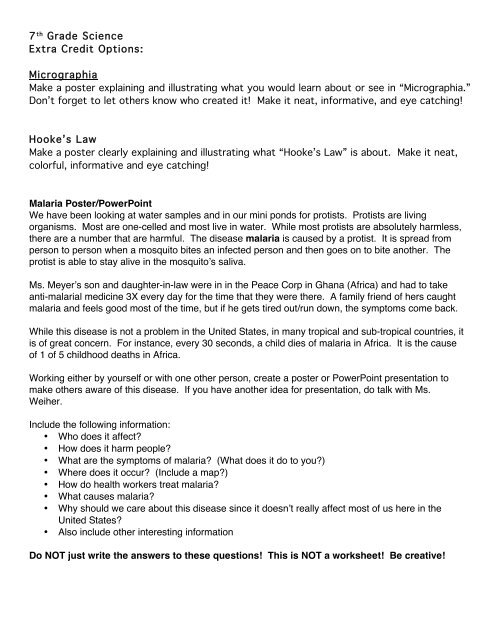7th Grade Science Extra Credit Options: Micrographia Make a poster ...
7th Grade Science Extra Credit Options: Micrographia Make a poster ... 7th Grade Science Extra Credit Options: Micrographia Make a poster ...
7 th Grade Science Extra Credit Options: Micrographia Make a poster explaining and illustrating what you would learn about or see in “Micrographia.” Don’t forget to let others know who created it! Make it neat, informative, and eye catching! Hooke’s Law Make a poster clearly explaining and illustrating what “Hooke’s Law” is about. Make it neat, colorful, informative and eye catching! Malaria Poster/PowerPoint We have been looking at water samples and in our mini ponds for protists. Protists are living organisms. Most are one-celled and most live in water. While most protists are absolutely harmless, there are a number that are harmful. The disease malaria is caused by a protist. It is spread from person to person when a mosquito bites an infected person and then goes on to bite another. The protist is able to stay alive in the mosquitoʼs saliva. Ms. Meyerʼs son and daughter-in-law were in in the Peace Corp in Ghana (Africa) and had to take anti-malarial medicine 3X every day for the time that they were there. A family friend of hers caught malaria and feels good most of the time, but if he gets tired out/run down, the symptoms come back. While this disease is not a problem in the United States, in many tropical and sub-tropical countries, it is of great concern. For instance, every 30 seconds, a child dies of malaria in Africa. It is the cause of 1 of 5 childhood deaths in Africa. Working either by yourself or with one other person, create a poster or PowerPoint presentation to make others aware of this disease. If you have another idea for presentation, do talk with Ms. Weiher. Include the following information: • Who does it affect? • How does it harm people? • What are the symptoms of malaria? (What does it do to you?) • Where does it occur? (Include a map?) • How do health workers treat malaria? • What causes malaria? • Why should we care about this disease since it doesnʼt really affect most of us here in the United States? • Also include other interesting information Do NOT just write the answers to these questions! This is NOT a worksheet! Be creative!
7 th <strong>Grade</strong> <strong>Science</strong><br />
<strong>Extra</strong> <strong>Credit</strong> <strong>Options</strong>:<br />
<strong>Micrographia</strong><br />
<strong>Make</strong> a <strong>poster</strong> explaining and illustrating what you would learn about or see in “<strong>Micrographia</strong>.”<br />
Don’t forget to let others know who created it! <strong>Make</strong> it neat, informative, and eye catching!<br />
Hooke’s Law<br />
<strong>Make</strong> a <strong>poster</strong> clearly explaining and illustrating what “Hooke’s Law” is about. <strong>Make</strong> it neat,<br />
colorful, informative and eye catching!<br />
Malaria Poster/PowerPoint<br />
We have been looking at water samples and in our mini ponds for protists. Protists are living<br />
organisms. Most are one-celled and most live in water. While most protists are absolutely harmless,<br />
there are a number that are harmful. The disease malaria is caused by a protist. It is spread from<br />
person to person when a mosquito bites an infected person and then goes on to bite another. The<br />
protist is able to stay alive in the mosquitoʼs saliva.<br />
Ms. Meyerʼs son and daughter-in-law were in in the Peace Corp in Ghana (Africa) and had to take<br />
anti-malarial medicine 3X every day for the time that they were there. A family friend of hers caught<br />
malaria and feels good most of the time, but if he gets tired out/run down, the symptoms come back.<br />
While this disease is not a problem in the United States, in many tropical and sub-tropical countries, it<br />
is of great concern. For instance, every 30 seconds, a child dies of malaria in Africa. It is the cause<br />
of 1 of 5 childhood deaths in Africa.<br />
Working either by yourself or with one other person, create a <strong>poster</strong> or PowerPoint presentation to<br />
make others aware of this disease. If you have another idea for presentation, do talk with Ms.<br />
Weiher.<br />
Include the following information:<br />
• Who does it affect?<br />
• How does it harm people?<br />
• What are the symptoms of malaria? (What does it do to you?)<br />
• Where does it occur? (Include a map?)<br />
• How do health workers treat malaria?<br />
• What causes malaria?<br />
• Why should we care about this disease since it doesnʼt really affect most of us here in the<br />
United States?<br />
• Also include other interesting information<br />
Do NOT just write the answers to these questions! This is NOT a worksheet! Be creative!
Sleeping sickness-Do the same for this disease as for malaria. This disease is also caused by a<br />
protist. You may need to modify the questions slightly. See Ms. Weiher if you are interested in this<br />
one!<br />
Cell Model<br />
<strong>Make</strong> a 3D cell model of either a plant or an animal cell. Include the following parts, as<br />
needed: cell membrane, cell wall, cytoplasm, nucleus, ribosomes, endoplasmic reticulum,<br />
vacuoles, golgi body, mitochondria, chloroplasts, chromosomes<br />
Your key should have a short definition of each part. Use the FOSS website or your “<strong>Science</strong><br />
Plus” book.<br />
Cell as a “factory”<br />
Using http://www.beyondbooks.com/lif71/4.asp<br />
or another source, make a <strong>poster</strong> illustrating and describing how a cell can be compared to a<br />
factory. You can draw or use pictures from another source.<br />
Other ideas? See Ms. Weiher!



